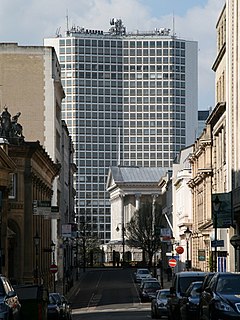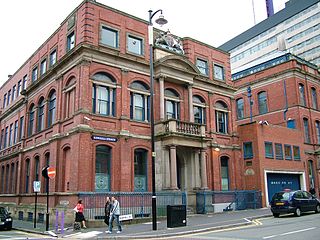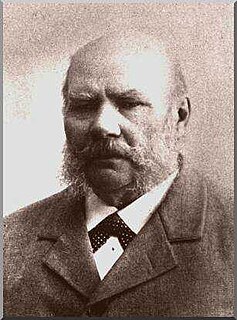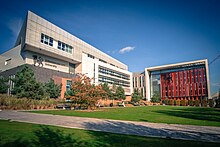
Art Nouveau is an international style of art, architecture, and applied art, especially the decorative arts, known in different languages by different names: Jugendstil in German, Stile Liberty in Italian, Modernisme català in Catalan, etc. In English it is also known as the Modern Style. The style was most popular between 1890 and 1910 during the Belle Époque period that ended with the start of World War I in 1914. It was a reaction against the academic art, eclecticism and historicism of 19th century architecture and decoration. It was often inspired by natural forms such as the sinuous curves of plants and flowers. Other characteristics of Art Nouveau were a sense of dynamism and movement, often given by asymmetry or whiplash lines, and the use of modern materials, particularly iron, glass, ceramics and later concrete, to create unusual forms and larger open spaces.

Birmingham City University is a university in Birmingham, England. Initially established as the Birmingham College of Art with roots dating back to 1843, it was designated as a polytechnic in 1971 and gained university status in 1992.

Hockley is a central inner-city district in the city of Birmingham, England. It lies about one mile north-west of the city centre, and is served by the Jewellery Quarter station. Birmingham's Jewellery Quarter continues to thrive in Hockley, and much of the original architecture and small artisan workshops have survived intact.

Although Birmingham in England has existed as a settlement for over a thousand years, today's city is overwhelmingly a product of the 18th, 19th, and 20th centuries, with little surviving from its early history. As it has expanded, it has acquired a variety of architectural styles. Buildings of most modern architectural styles in the United Kingdom are located in Birmingham. In recent years, Birmingham was one of the first cities to exhibit the blobitecture style with the construction of the Selfridges store at the Bullring Shopping Centre.

The Big City Plan is a major development plan for the city centre of Birmingham, England.

The Jewellery Quarter is an area of central Birmingham, UK, in the north-western area of Birmingham City Centre, with a population of around 19,000 people in a 1.07-square-kilometre (264-acre) area.

Charles Robert Ashbee was an English architect and designer who was a prime mover of the Arts and Crafts movement, which took its craft ethic from the works of John Ruskin and its co-operative structure from the socialism of William Morris.

The Birmingham School of Art was a municipal art school based in the centre of Birmingham, England. Although the organisation was absorbed by Birmingham Polytechnic in 1971 and is now part of Birmingham City University's Faculty of Arts, Design and Media, its Grade I listed building on Margaret Street remains the home of the university's Department of Fine Art and is still commonly referred to by its original title.

John Henry Chamberlain, generally known professionally as J. H. Chamberlain, was a British nineteenth-century architect based in Birmingham.

The Birmingham Assay Office, one of the four assay offices in the United Kingdom, is located in the Jewellery Quarter, Birmingham. The development of a silver industry in 18th century Birmingham was hampered by the legal requirement that items of solid silver be assayed, and the nearest Assay Offices were in Chester and London. Matthew Boulton and Birmingham's other great industrialists joined forces with silversmiths of Sheffield to petition Parliament for the establishment of Assay Offices in their respective cities. In spite of determined opposition by London silversmiths, an Act of Parliament was passed in March 1773, just one month after the original petition was presented to Parliament, to allow Birmingham and Sheffield the right to assay silver. The Birmingham Assay Office opened on 31 August 1773 and initially operated from three rooms in the King's Head Inn on New Street employing only four staff and was only operating on a Tuesday. The first customer on that day was Matthew Boulton.

Birmingham Guild of Handicraft was an Arts and Crafts organisation operating in Birmingham, England, established at the end of the 19th century.

Associated Architects is a leading AJ100 architectural firm with offices in Birmingham and Leeds, England. Founded in 1968, the practice has a broad portfolio of work including arts, commercial offices, residential, masterplanning and leisure and is particularly known for its work in education. It has received many national awards including over 30 RIBA Awards, together with the RIBA Sustainability Award. For its commercial work it has been awarded 9 BCO Awards, British Council for Offices. The practice designed the George Davies Centre, at the University of Leicester, currently the largest (non-domestic) building in the UK to be Passivhaus accredited. It is also responsible for the design and delivery of Bartholomew Barn, the UK's first "multi-comfort" building, a benchmark pioneered by Saint Gobain. The building has set a new bar for sustainable architecture.

Birmingham City Centre, also known as Central Birmingham and often known locally as town, is the central business district of Birmingham, England. Following the removal of the Inner Ring Road, the city centre is now defined as being the area within the Middle Ring Road. The city centre is undergoing massive redevelopment with the Big City Plan, which means there are now nine emerging districts and the city centre is approximately five times bigger.

Arthur Joseph Gaskin RBSA was an English illustrator, painter, teacher and designer of jewellery and enamelwork.

August Wilhelm Holmström was a Finnish silver- and goldsmith. Born in Helsinki, Finland, he became an apprentice at the workshop of jeweller Karl Herold in St. Petersburg 1845—1850, master in 1857 with his own workshop.

Birmingham has a distinctive culture of art and design that emerged in the 1750s, driven by the historic importance of the applied arts to the city's manufacturing economy. While other early industrial towns such as Manchester and Bradford were based on the manufacture of bulk commodities such as cotton and wool, Birmingham's economy from the 18th century onwards was built on the production of finished manufactured goods for European luxury markets. The sale of these products was dependent on high-quality design, and this resulted in the early growth of an extensive infrastructure for the education of artists and designers and for exhibiting their works, and placed Birmingham at the heart of debate about the role of the visual arts in the emerging industrial society.

John Paul Cooper was a British architect and a leading craftsman in the Arts and Crafts Movement, specialising in metalwork and jewellery. He is particularly noted for the use of materials such as shagreen and ostrich egg in combination with precious metals and gemstones.

Howell James & Company was a firm of jewellers and silversmiths based in Regent Street in London which operated between 1819 and 1911. In 1876 they added galleries showing professional art pottery and the fashionable amateur china painting, and immediately became the main London venue for this.
Thomas Fattorini Ltd is a manufacturing jeweller and designer-maker of awards, trophies, ceremonial swords, civic insignia, medals and name badges. The company is located on three sites in Manchester, Birmingham and London with their head office in Skipton, North Yorkshire.
Frederick James Partridge (c.1877-1946) was an English jeweller, silversmith and teacher of jewellery making, active circa 1901–1930. His works are in the Art Nouveau style. He has been called the "British René Lalique".




















